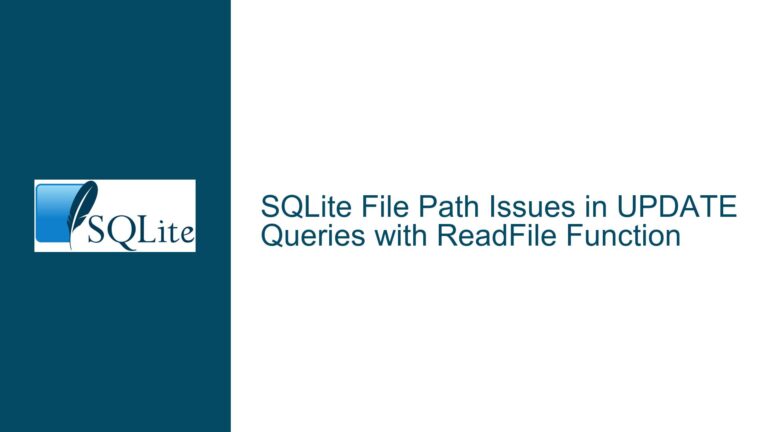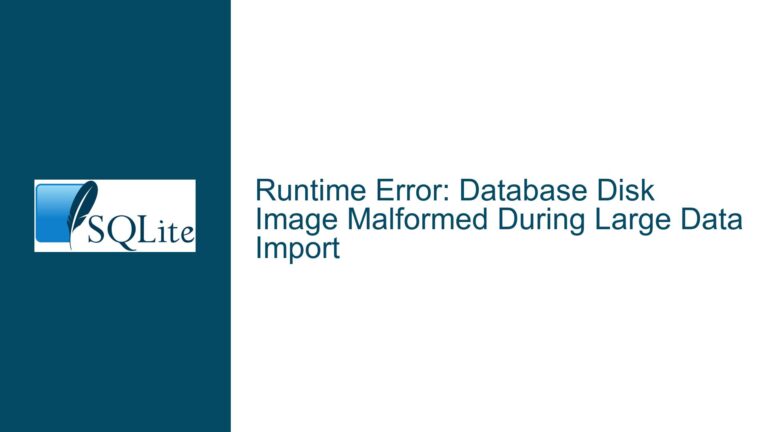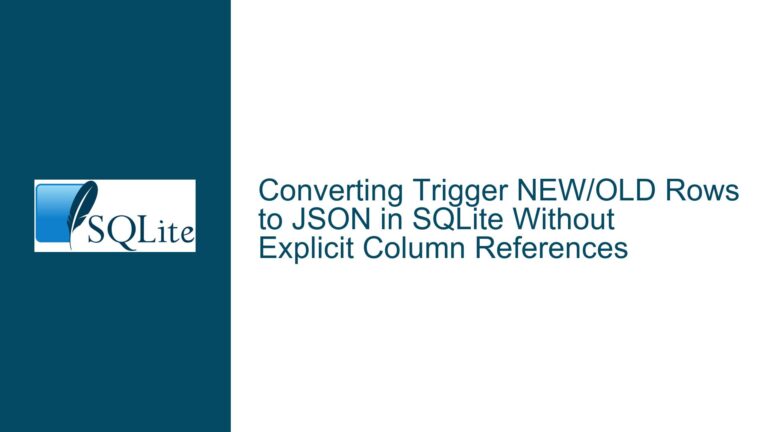Handling Double Quotes in TSV Imports with SQLite3 CLI’s .import Command
Understanding SQLite3 CLI’s .import Behavior with TSV Files Containing Double Quotes
Issue Overview
The SQLite3 Command Line Interface (CLI) provides a convenient .import command for loading data from text files into database tables. However, users often encounter unexpected behavior when importing Tab-Separated Value (TSV) files containing double quotes (") within field values. By default, the .import command treats double quotes as special characters for field quoting and escaping, even when working with TSV files. This leads to parsing errors or corrupted data when fields contain unescaped double quotes or are not explicitly wrapped in quotes.
For example, consider a TSV file with the following line:
apple "banana cherry "date
If the second field ("banana) contains a leading double quote, SQLite’s .import will interpret it as the start of a quoted field. Since the field does not end with a closing quote, the parser may misread subsequent fields or fail entirely. Similarly, a field like a"b (where the quote is not at the start) might be parsed correctly under some configurations but cause issues if the parser expects quoted fields to follow CSV-style escaping rules.
The core problem stems from SQLite’s adherence to CSV-like parsing logic for all text-based imports, regardless of the field separator. The .import command assumes that fields starting with a double quote are quoted per RFC 4180 (the CSV standard), requiring embedded quotes to be doubled and the field to be enclosed in quotes. This creates incompatibility with TSV files that use double quotes as regular characters without adhering to CSV-style quoting conventions.
Possible Causes
Default CSV Parsing Logic:
The.importcommand is fundamentally designed for CSV files. Even when using tab separators, SQLite applies CSV-style quote handling. If a field begins with a double quote, the parser expects the entire field to be quoted, with embedded quotes escaped by doubling them (e.g.,"He said, ""Hello"""). Fields not following this convention trigger parsing errors.Ambiguity in TSV Standards:
Unlike CSV, which has a well-defined standard (RFC 4180), TSV lacks a universal specification. Some TSV implementations allow fields to contain unescaped double quotes, while others require quoting. SQLite’s CLI does not explicitly document its TSV import behavior, leading to confusion about whether quoting is optional or mandatory.Interaction Between .mode and .import:
The CLI’s.modecommand primarily controls output formatting (e.g.,.mode csv,.mode list). However, it also indirectly influences the.importcommand’s parsing logic. For instance,.mode csvforces.importto use CSV parsing rules, while.mode asciidisables quote processing entirely. Misconfiguring these settings can lead to unintended parsing behavior.Header Handling and Table Creation:
When importing into a new table, the first row of the input file is used to define column names. If the.headerssetting is off or misconfigured, the parser may treat the header row as data, causing schema mismatches or invalid column names.
Troubleshooting Steps, Solutions & Fixes
Step 1: Disable Quote Processing with .mode ascii
To prevent SQLite from interpreting double quotes as special characters during import:
Set the CLI to ASCII mode:
.mode asciiThis mode uses non-printable ASCII characters (RS and US) as separators by default but can be overridden to use tabs and newlines.
Define custom separators:
.separator "\t" "\n"This explicitly sets the field separator to tab (
\t) and the record separator to newline (\n).Import the TSV file:
.import data.tsv MyTableCritical Note: The order of commands matters.
.mode asciimust be set before.separator.
Step 2: Handle Headers Correctly
If the TSV file’s first row contains column headers:
Enable header processing:
.headers onThis ensures the first row is treated as column names rather than data.
Create the table explicitly (optional):
If the table does not exist, SQLite auto-creates it using the header row. To avoid case sensitivity issues or reserved keyword conflicts, predefine the schema:CREATE TABLE MyTable (Column1 TEXT, Column2 TEXT);
Step 3: Validate and Preprocess Input Files
For files with inconsistent formatting:
Remove leading/trailing quotes:
Use a script to strip quotes from fields not intended to be quoted. For example, a Perl one-liner:perl -pe 's/^"//; s/"$//; s/""/"/g' data.tsv > cleaned.tsvEscape embedded quotes (if required):
If some fields require quoting, manually escape quotes by doubling them:sed 's/"/""/g' data.tsv > escaped.tsv
Step 4: Use Alternative Import Methods
If the CLI’s .import remains problematic:
Leverage SQLite’s
INSERTstatements:
Read the TSV file programmatically and execute batched inserts. For example, in Python:import sqlite3, csv conn = sqlite3.connect('mydb.db') cursor = conn.cursor() with open('data.tsv') as f: reader = csv.reader(f, delimiter='\t') for row in reader: cursor.execute('INSERT INTO MyTable VALUES (?, ?)', row) conn.commit()Utilize External Tools:
Convert TSV to SQLite’s native format using tools likesqlite-utils(Python) orcsvkit:csvsql --tabs --db sqlite:///mydb.db --insert data.tsv
Step 5: Update to the Latest SQLite Version
Recent SQLite versions (3.41.0+) include improvements to the CLI’s import logic. Verify your version with:
sqlite3 --version
If outdated, download the latest precompiled binaries from the SQLite website.
Step 6: Consult Updated Documentation
The SQLite CLI documentation has been revised to clarify .import behavior. Key takeaways:
.mode asciidisables quote processing..separatormust be set after.modefor custom delimiters.- Header handling depends on
.headersand table existence.
By following these steps, users can reliably import TSV files with embedded double quotes without triggering parsing errors. The solution hinges on reconfiguring the CLI’s import mode to treat tabs and newlines as literal separators while disabling CSV-style quote interpretation. For advanced use cases, preprocessing scripts or programmatic imports offer greater control over data sanitization and error handling.






